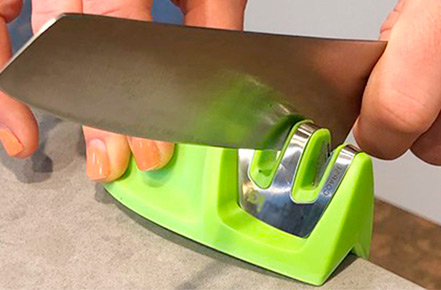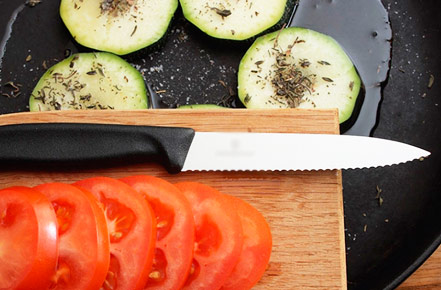-
-

-
- read more
- 15 187
-
-
-
How To Use A Knife Sharpener And Sharpen Your Knife
There are numerous ways how to properly sharpen a knife. The best way to sharpen a knife will depend on what things you have handy in your kitchen now. You ...
-
07 April 2020
-
How To Use A Knife Sharpener And Sharpen Your Knife
-
-
A Comprehensive Guide of Gyuto vs Santoku Kitchen Knifes
Likes:Views:195Last Updated: 06 August 2021Japanese knives have always been one of the favorite kitchen appliances of most households. The two most premium varieties of this type are gyuto and santoku. Starting from the features to in-depth comparison, everything is there in this gyuto vs santoku guide!
There can be hundreds of kitchen appliances in your house, but most tasks will seem difficult without a proper knife. Therefore, you must invest in a good quality Japanese chef knife as they are known to be the best on the market following the customer reviews and ratings. When buying the cutter, you might get confused on which type to choose because there are various types of Japanese style knives. But know that the gyuto and santoku are the best varieties for a kitchen knife set. Now, you must be wondering which one you should invest in. Read the full santoku vs gyuto knives comparison to find the answer!
Contents
What Exactly is a Gyuto Knife?

A gyuto knife is a kitchen knife that looks much like a western-style classic cutter, but it has a double bevel, a tall heel, and a comparatively thinner shape. These blades historically belong to either French or German, or both as per the arguments. It was imported into the Japanese market during the second half of the 19th century, also popularly known as the Meiji era. After that, the Japanese trade made a few changes in the cutter’s style, and soon it became one of the many types of Japanese cutters.
Now, let us tell you what is a gyuto knife used for. Well, one can use it for cutting various ingredients like fruits, vegetables, herbs, fishes, and meat. Its tall and curved heel is great for pull-cutting, rock-chopping, and other heavy activities. It is a multipurpose kitchen tool that is worth buying.
Top 5 the Best Gyuto Knives
Features
The features of the Japanese gyuto knife are as follows:
- Blade length: The length of this cutter’s length is both thinner and lighter compared to a western classic knife. The usual length of the blade is around 180 mm to 300 mm. However, the best gyuto knife can also have a length of up to 360 mm. Chefs usually use a length ranging from 240 mm to 270 mm.
- Blade shape: The blade is slightly curved and has a pointed tip. This shape is great for cutting and chopping purposes.
- Cutting style: The curved shape of the cutter helps in easy cutting. The cuts are also smooth and sharp. You will have to put much less effort while cutting heavy ingredients like meat and fish.
- Double bevel: The knife has a double bevel. It is thin yet sturdy in nature.
What Exactly is a Santoku Knife?
Similar to gyuto, the santoku Knife is also a multipurpose cutter. During the 1940s, the Japanese people implemented the features of their local meat cleaver into a Western chef knife. And the result was the santoku knife, which is now widely used as a safe kitchen tool. As per the experts who collected info for the santoku knife review, the origin of this type is in Japan. However, it is a blend of both Japanese and Western cutters.
If you are wondering what is a santoku knife used for, then know that it is used for multiple purposes like cutting, dicing, mincing, and so on. You can use the blade for cutting soft as well as hard ingredients, including fish and meat. Therefore, there a various santoku knife uses for every kitchen.
Top 5 the Best Santoku Knives
Features
The features of the best santoku knives are as follows:
- Blade length: The santoku blade is shorter compared to the gyuto blade. It is around 5 to 10 inches, which is a standard size for kitchen cutters. Every chef finds this blade length quite comfortable, even the ones who are short-handed.
- Cutting style: The cutting style of this cutter is quite smooth, and it can easily cut most ingredients. Even the hard ingredients like fishes and meat can be cut with it.
- Blade shape: It has a full tang flat blade, making it easier to cut vegetables. Cutting becomes more convenient with a flat blade.
Gyuto vs Santoku Differences
Gyuto Santoku Uses Dicing, chopping, mincing Chopping, mincing, dicing Blade sharpening skill Intermediate Intermediate Bevel Double bevel Double or single bevel Weight Heavier Lighter Blade shape A slightly curved and pointed tip Flat blade with a rounded tip Price Mid to high High
Similarities
The similarities between the gyuto vs santoku knives are:

- Versatility: Both knives are versatile as they can do multiple tasks like chopping, cutting, slicing, mincing, and a lot more. Therefore, both models are effective for kitchen works.
- Material: Both gyuto knife vs santoku has a blade made of ceramics, carbon steels, and stainless steel, and so on. The handle is made up of wood, plastic, and stainless steel.
- Blade sharpening skill: The two models have an intermediate sharpening skill. Therefore, you will get the same sharpness no matter which variety you choose.
Differences
The differences between the gyuto chef’s knife vs santoku are:
- Origin: The origin of the gyuto knife is known to be from France and Germany. On the other hand, the santoku is originated in Japan by their people.
- Blade shape: Even though there is no huge difference in the shape, as per our gyuto vs santoku reviews, we will say that the shape differs slightly. The shape of the gyuto blade is slightly curved, whereas in santoku the blade is flat.
- Bevel: gyuto comes with a double bevel blade. Japanese santoku knife has either a double or a single bevel blade.
Overall Pros and Cons
Pros Cons Gyuto - Multipurpose cutter
- Double bevel blade and sharp cutting edge
- Affordable price
- Heavier
Santoku - All-purpose cutter
- Flat blade suitable for vegetable cutting
- Lightweight
- A bit expensive
Final Word: Which One to Buy?
We hope this comprehensive guide has helped you find out the comparison gyuto vs santoku knives. As per our experts, both the knives are wonderful in their jobs. However, if you have a good budget, then go for a top-rated santoku knife as it is lighter. But for those who are tight on budget, gyuto, too, is an excellent option. Do tell us which one are you planning to buy?
RELATED BLOGS-
-

-
- read more
- 6 88
-
-
-
How To Sharpen A Knife At Home
Whether we are talking about expensive or cheap knives, with or without a ceramic wrap or a wooden handle, they are all subject to the same issue, with time: they ...
-
11 December 2019
-
How To Sharpen A Knife At Home
-
-

-
- read more
- 15 162
-
-
-
Bamboo Cutting Boards Care
Do you agree that a chopping block is one of the essential kitchen utensils you can have? They come in several shapes, sizes, and thicknesses. You might have heard conflicting ...
-
19 August 2019
-
Bamboo Cutting Boards Care
related reviews
Share your thoghts








